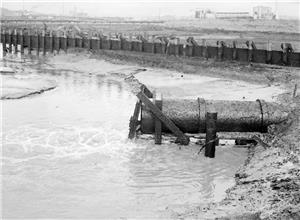On July 20, 1966, Metro's West Point wastewater treatment plant is dedicated and begins treating sewage, which since 1912 had been dumped into Puget Sound. By 1970, the plant will handle sewage that had been dumped into the Duwamish River and Elliott Bay, making Seattle's waterfront, "One of the cleanest in the world" (Lane). West Point is a point of land that extends into Puget Sound from Fort Lawton and Discovery Park.
In 1913, Seattle City Engineer Reginald H. Thomson (1856-1949) completed a mammoth brick sewer, 12 feet in diameter, that ran across the north end of Seattle to a beach at Fort Lawton. A pipe carried the effluent to a point about 25 feet underwater. Raw sewage from homes and businesses was discharged into the salt water where, it was believed at the time, nature would take care of it. A fan-shaped plume could easily be seen from the air and the beach at West Point became coated with a black slime. Nearby beaches were often closed because of bacterial contamination. By the mid 1950s, 40 million gallons per day flowed into the sound.
After it was formed in 1958, Metro -- the Municipality of Metropolitan Seattle -- planned a 125-million-gallon-per-day plant at West Point to provide primary treatment. Primary treatment removes about half the solids from sewage and then chlorinates the discharge to kill harmful organisms. At the time, this was the standard method of wastewater treatment for a city like Seattle. Work on the West Point plant began in 1962 and it cost $11.9 million.
Additional trunk lines were built. In 1970, Seattle's old Diagonal Avenue treatment plant was closed and the Elliott Bay interceptor sewer was completed. Sewage flowed to West Point. Dissolved oxygen levels in the Duwamish River and in Elliott Bay (an indicator of how much oxygen in the water is available for aquatic life) rose from three-tenths of a milligram per liter to more than four milligrams per liter. By 1995, the dissolved oxygen levels climbed to eight milligrams per liter.

